As the largest island in the Balearics, there are plenty of Mallorca towns, historic cities and beautiful places to visit in Mallorca, all waiting to be explored. From the quaint, seaside towns along the eastern Mallorcan coast to the world-renowned holiday resorts of the south-west, and from the windswept Tramuntana mountain range running through the island’s centre to the picturesque villages at its base, there’s much more to Mallorca than Palma.
This post shares the best towns and cities in Mallorca. They are sure to rapidly make their way to the top of your Spanish island bucket list, so let’s explore what makes them so special.
Palma de Mallorca
Palma de Mallorca, oftentimes just known as Palma, is the island’s capital and largest city. With the international airport so close to this Mallorcan city, most trips begin here – and with good reason!
There’s plenty to do in Palma, ranging from sunny-day activities on glorious sandy beaches to historical tours of the royal residence, Palau de l’Almudaina, and the enormous Palma Cathedral. It’s in a spectacular setting, reflected in waters of a man-made lake, which symbolises the sea before land reclamation moved the building inland.
To best experience this city, join a bus tour that takes in all it has to offer. This will also save you the climb to find the best views of the city. For those, head to Castell de Bellver, a unique circular castle perched high a hill to the west of the island.
Shopaholics and foodies, don’t worry – Palma’s got you covered too, with some of the best restaurants and boutiques the island has to offer.
Stay: Innside by Melia Palma Center for a great value hotel with rooftop terrace, pool and just a 15-minute walk to Palma Cathedral.
Porto Cristo
A modern, peaceful and family-friendly town has built up around an old stone fishing village at Porto Cristo, on Mallorca’s east coast. The marina and fancy white villas dotted along the shore make this a popular place with yacht owners, but there’s no need to be a millionaire to visit!
Boat tours and water sports are the order of the day here, and though the town’s sandy beach is small, it’s perfectly formed and very welcoming. In the town itself, admire the various churches and side streets, but make sure you return to the marina to watch the sunset from one of the many restaurants on the seafront.
The nearby Cuevas del Drach are some of the best caves on Mallorca, and one of the best things to do here full stop. The name translates from Mallorqui to English as ‘the caves of the dragon’, but I’m pretty sure the caves aren’t home to one. Tourists come from all over to explore the chambers and interpret the formations. Each guided tour culminates in a visit to the underground lake where a classical music performance demonstrates the incredible acoustics before you emerge, blinking into the sunlight.
Stay: Hotel Rural Son Mas – a few minutes’ drive outside of Porto Cristo, but worth it for a tranquil stay at this stylish hotel, set in a 17th-century building.
Alcudia
Well worth the 45-minute drive north-east from Palma is Alcudia – a drop-dead gorgeous medieval town that welcomes history-loving tourists with open arms. The town has had a variety of different rulers since being founded by the Romans over 2000 years ago, and while remnants of this history are limited to the ruins of Pollentia just outside the town, you can still see the medieval city walls and buildings in Alcudia itself.
If you’re visiting Mallorca in winter, make sure you stop by the Església de Sant Jaume d’Alcúdia for spectacular photo opportunities outside the church. Venture inside, and you’ll be treated to an incredible nativity display, complete with moving parts and sound effects!
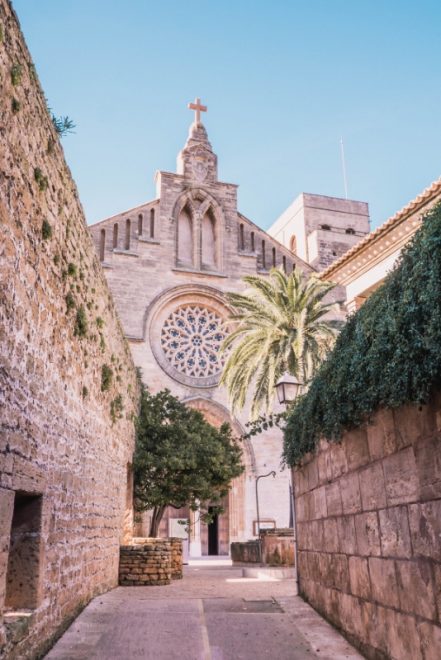
Alcudia features many arts and crafts shops and plenty of restaurants with terraces for al fresco dining, but for more of a resort feel, head to nearby Port d’Alcudia and its sandy beaches on the coast.
Stay: Hotel Can Mostatxins in the heart of Alcudia’s old town. This stunning hotel features beautiful interiors, with exposed stone walls and a cave-like spa area with hot tub.
>> Keen to avoid the summer crowds? Discover everything you need to know about visiting Mallorca in winter with this travel guide.
Pollenca
Pollenca is a historic town, slightly further inland than nearby Alcudia, but just as charming. There are remnants of its Roman and Medieval history still visible, with impressive churches, winding back streets and squares, as well as a Roman bridge, ‘Pont Roma’, which is still in use.
If you’ve got the energy, take a 45-minute mini hike to the hilltop of Puig de Pollenca, for some of the best views on the island.
Despite its visual similarities with Alcudia, Pollenca attracts fewer tourists than other Mallorca towns, making it a good place to join the locals for a coffee or wander through the Sunday market without the crowds.
However, if you don’t mind the summer crowds, head to the lively and touristy Port de Pollenca with its large beach and holiday vibes.
Stay: Son Brull Hotel & Spa is one of the most luxurious on the island, set in a former monastery to the south of Pollenca. Rooms are exceptionally designed with modern takes on traditional features and beautiful views out to the surrounding landscape.
Valldemossa
In my opinion, Valldemossa is one of the most stunning towns in Mallorca, and deserves its place on any list of beautiful places to visit on the island. Sadly, that also makes it one of the most popular, but out-of-season travellers will enjoy the fantastic reward of seeing it without the crowds.
This charming town is made up of quaint stone alleyways and houses with doorways decorated by fresh green plants and flowers. But what puts the ‘vall’ in Valldemossa is the beautiful valley views you’ll be treated to at one of the many lookout points.
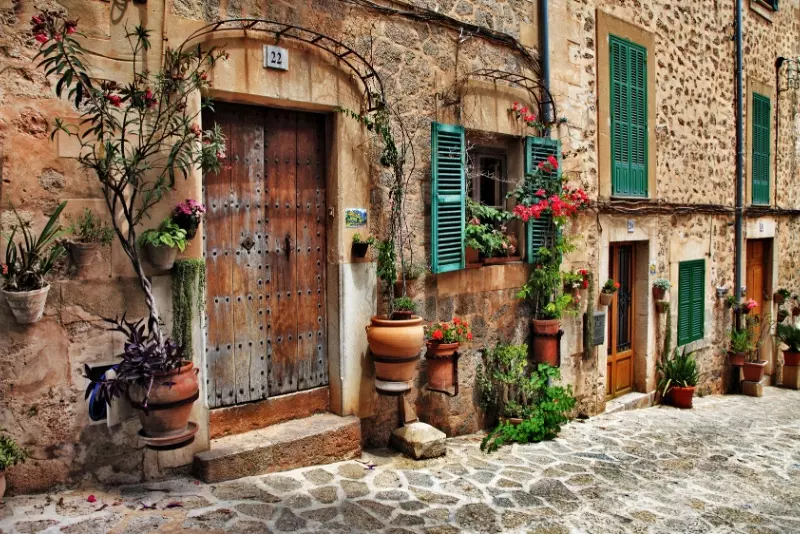
Other than the views of the valley below, the most popular attraction is the Carthusian Monastery. This beautiful stone building was originally a royal residence until it was donated to Carthusian monks and became a monastery in 1399. At the end of their occupation in 1835, the building was privatised and became a source of great inspiration for the composer Frederic Chopin, and novelist George Sand during their stay in 1838. Today it houses a museum dedicated to their work as well as many other historical artefacts, art collections and manicured grounds.
Stay: Don’t miss the chance to stay in one of Valldemossa’s famous townhouses at Macarena’s House. These self-catering houses have a fully-equipped kitchen, comfortable rooms and even a patio or terrace for al fresco dining.
Arta
Secluded from the rest of the island in the Llevant Natural Park, Arta is Mallorca’s hidden gem. An ancient settlement surrounded by an old stone wall, this village retains its original Mallorquin character and atmosphere.
That doesn’t mean there isn’t anything to do here though – far from it! There is a popular craft market on Tuesdays, the Bronze Age settlement of Ses Paisses and Santuari de Sant Salvador – a picturesque hilltop fortress overlooking the town.
While you’re in the area, it would be rude not to visit Llevant Natural Park, which boasts a large mountain range, hiking trails and plenty to keep birdwatchers occupied too. For those that prefer to be more enclosed, the underground caverns of Caves d’Arta are perfect for you.
Stay: Hotel Ca’n Moragues for a stay in beautiful countryside at a converted manor house. As well as the comfortable rooms, enjoy the hotel’s grounds, orange groves and outdoor swimming pool too.
Soller
Soller is a traditional Mallorquin town set amongst orange groves and lush mountain scenery. Mallorca’s famous winding alleyways and townhouses dotted with fresh plants are on display here too. A picturesque old railway links Soller to the capital, while a rickety tram heads to the coast, making it a wonderful base for exploring the island.
The town’s highlight is the Plaça Constitució – a beautiful old town square with plenty of cafes serving fresh local produce and a good side order of Balearic atmosphere. From here, it’s hard not to admire the Sant Bartomeu church, which dates back to the 13th century. Its modern facade with tall spires and archways was added in 1904. If it looks familiar, that might be due to it being designed by one of Gaudi’s students, Joan Rubid.
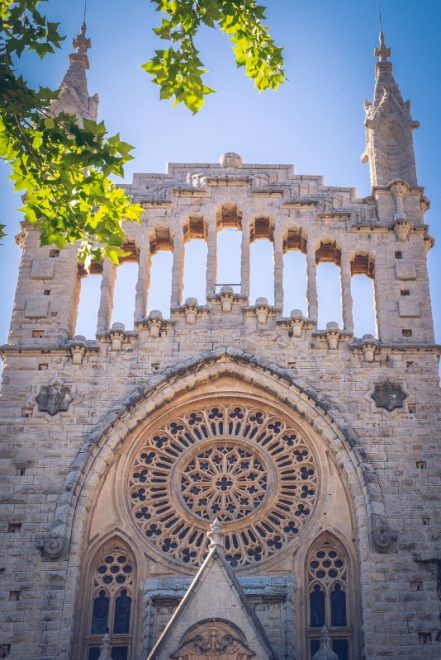
Stay: There are plenty of fincas (rural accommodation dedicated to agriculture) in the area for a sustainable trip to Mallorca, but to truly appreciate Soller’s charms, opt for a central stay at Hotel El Guía just a minute’s walk to the main square.
>> For advice on the most eco-friendly places to stay and eat, visit this travel guide to a sustainable trip to Mallorca.
Deià
Between Soller and Valldemossa you’ll find Deià – a picturesque village with spectacular views over the mountains and the Mediterranean Sea. Its position in the Tramuntana mountain range – a UNESCO World Heritage Site – makes it a popular place to hike, walk or just admire the landscape.
In the village, tourists can visit English Novelist and Poet Robert Graves’ museum in his former home, wander through the alleyways, and enjoy local gastronomy in one of the many places to eat and drink.
Make sure you leave enough time to walk 30 minutes down to Cala Deià – a small pebble beach surrounded by craggy cliffs and crystal clear waters.
Stay: Hotel Es Moli, set on a hill just outside Deià in a 17th-century mansion. The hotel offers old-time charm with an outdoor pool and a private beach, but the highlight is the panoramic views of the sea, the village and Tramuntana mountains.
While not strictly towns or cities, these attractions are still worthy of a spot on this list of the best places in Mallorca to visit on your next trip.
Santuari de Lluc
Santuari de Lluc is a large monastery complex and an important pilgrimage site for Christians set in the Trumantana mountain range. Regardless of religious beliefs, visitors can admire the pretty stone architecture, with certain aspects of the interior renovated by famous Spanish architect Gaudi just over 100 years ago. If you’re lucky, you may even hear the boys’ choir sing at the daily concerts in the chapel.
Castell d’Alaró
Castell d’Alaro is a ruined castle on top of a mountain above Alaro, to the west of the island. It’s a popular, if challenging, 2-hour walk from the town. Your effort is made worthwhile by the spectacular views over the Tramuntana mountains and out to the Mediterranean Sea.
Cap de Formentor
Cap de Formentor is a 20km long peninsula and the most northerly tip of the island. A windy but scenic drive takes you up the lighthouse where visitors can walk around the rocky landscape at its base. The views all along the peninsula are beautiful, thanks to the craggy cliffs and grass-tipped hills all over.
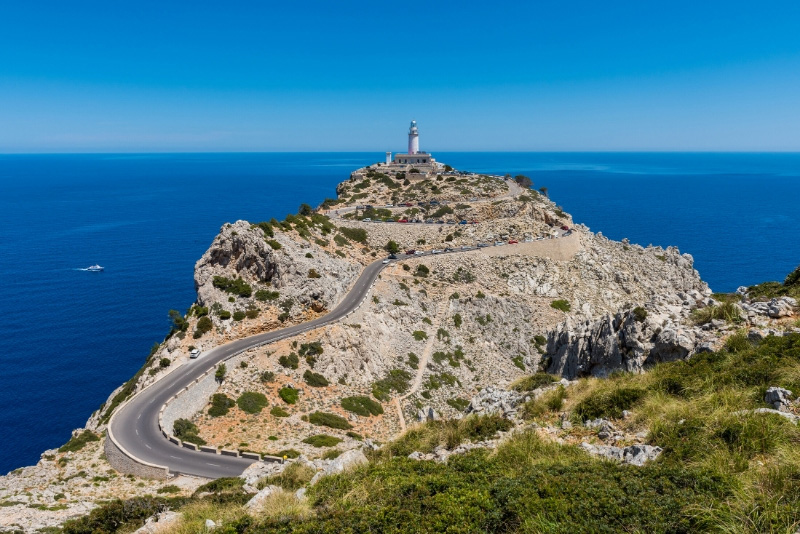
Getting around Mallorca
Each of the towns listed in this post can be reached by public transport, thanks to the extensive bus network run by EMT in Palma, and various other private companies on the rest of the island.
Buses are cheap but can be slow owing to the number of stops on each line. It’s also not always possible to travel between destinations on separate lines and you may need to return to Palma each time you want to head in a different direction.
There are also a few train lines connecting Palma to towns on the island, but the destinations are limited to inland rather than coastal towns. Make sure you visit the TIB’s website for the most up-to-date information on bus routes and train timetables.
For speed, comfort and ease of getting around, consider hiring a car from Palma airport for the duration of your trip.
>> Compare prices for car rental at Holiday Autos, with free cancellation!
***
With so many beautiful places to visit in Mallorca, towns and cities alike, you certainly won’t be bored here! Hopefully, we’ve given you plenty of inspiration for your next visit to this beautiful Balearic Island, so all that’s left is for you to explore!
Like this? Pin it to your Spain travel board for later!
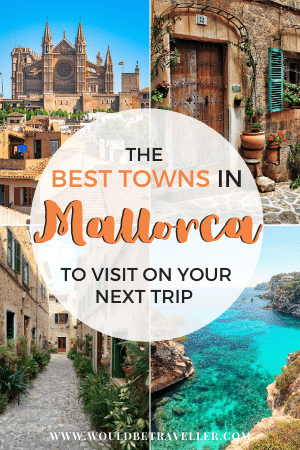

Amazing! I know nothing about traveling all over the country, what a wonderful looking place to explore.